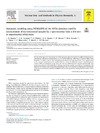Identificador persistente para citar o vincular este elemento:
https://accedacris.ulpgc.es/jspui/handle/10553/55769
| Título: | Automatic modeling using PENELOPE of two HPGe detectors used for measurement of environmental samples by γ-spectrometry from a few sets of experimental efficiencies | Autores/as: | G. Guerra, J. García Rubiano, Jesús Winter Althaus, Gabriel G. Guerra, A. Alonso Hernández, Héctor Arnedo Ayensa, Miguel Ángel Tejera Cruz, Alicia María Mosqueda, F. Martel Escobar, Pablo Bolivar, J. P. |
Clasificación UNESCO: | 251007 Oceanografía física | Palabras clave: | Efficiency calibration Gamma-ray spectrometry Monte Carlo simulation Reference materials |
Fecha de publicación: | 2018 | Publicación seriada: | Nuclear Instruments and Methods in Physics Research, Section A: Accelerators, Spectrometers, Detectors and Associated Equipment | Resumen: | The aim of this paper is to characterize two HPGe gamma-ray detectors used in two different laboratories for environmental radioactivity measurements, so as to perform efficiency calibrations by means of Monte Carlo Simulation. To achieve such an aim, methodologies developed in previous papers have been applied, based on the automatic optimization of the model of detector, so that the differences between computational and reference FEPEs are minimized. In this work, such reference FEPEs have been obtained experimentally from several measurements of the IAEA RGU-1 reference material for specific source-detector arrangements. The models of both detectors built through these methodologies have been validated by comparing with experimental results for several reference materials and different measurement geometries, showing deviations below 10% in most cases. | URI: | https://accedacris.ulpgc.es/handle/10553/55769 | ISSN: | 0168-9002 | DOI: | 10.1016/j.nima.2017.10.076 | Fuente: | Nuclear Instruments and Methods in Physics Research, Section A: Accelerators, Spectrometers, Detectors and Associated Equipment [ISSN 0168-9002], v. 880, p. 67-74 |
| Colección: | Artículos |
Citas SCOPUSTM
7
actualizado el 08-jun-2025
Citas de WEB OF SCIENCETM
Citations
6
actualizado el 08-jun-2025
Visitas
160
actualizado el 10-ago-2024
Descargas
340
actualizado el 10-ago-2024
Google ScholarTM
Verifica
Altmetric
Comparte
Exporta metadatos
Los elementos en ULPGC accedaCRIS están protegidos por derechos de autor con todos los derechos reservados, a menos que se indique lo contrario.
